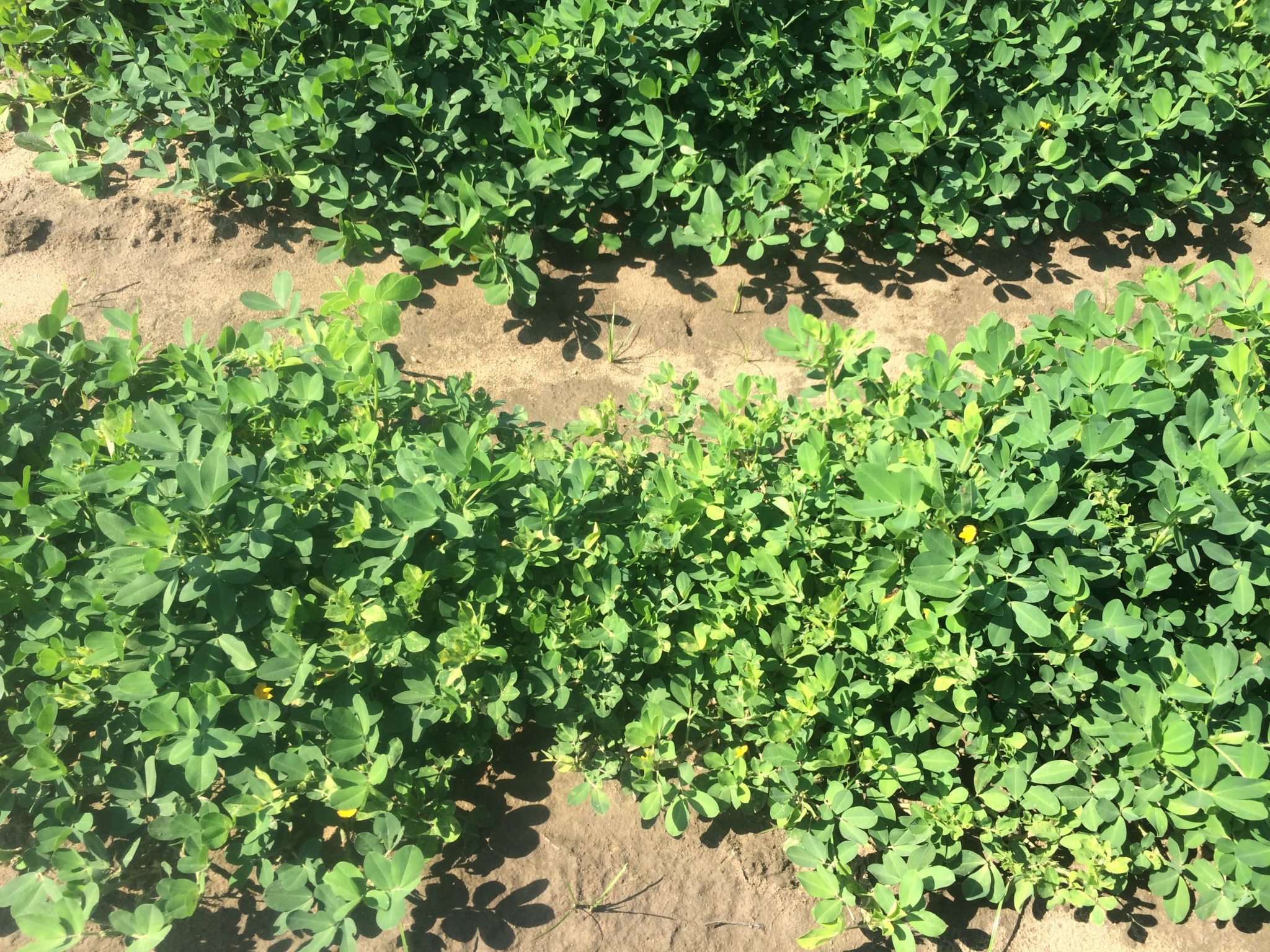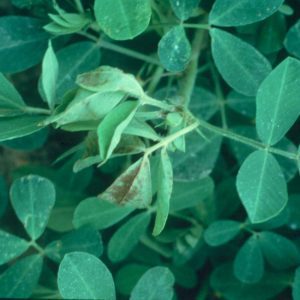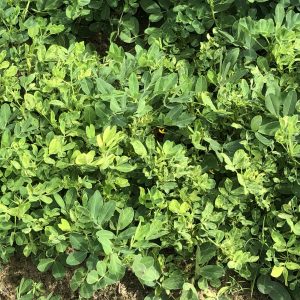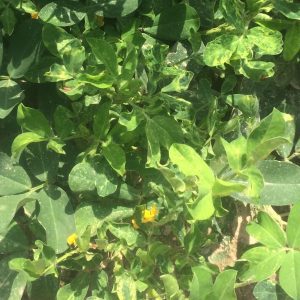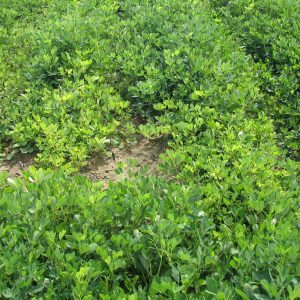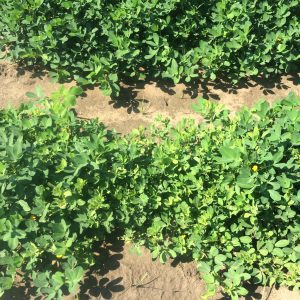Crop Production

Tomato spotted wilt (TSW), caused by tomato spotted wilt virus (TSWV; Family Bunyaviridae; Genus Tospovirus), is an important disease of field, vegetable, and ornamental crops grown in temperate and subtropical regions worldwide.
TSWV has one of the widest host ranges of known plant viruses as it infects more than 1,000 species in 85 families including peanut, tomato, pepper, potato, cucurbits, lettuce, eggplant, tobacco, chrysanthemum, gloxinia, gladiolus, impatiens, begonia, and several weed species. In peanuts, TSWV stunts plants, reduces yield, and causes shriveled, misshapen pods. The disease has become widely distributed across Alabama and has become a major obstacle for peanut producers in the southeastern United States. In terms of important weed hosts, Florida beggarweed, jimsonweed, lambsquarters, morning glory, and pigweed are known hosts for TSWV and are found in Alabama peanut fields.
TSWV is spread from plant to plant by at least nine species of thrips, three of which are found in peanuts in Alabama. However, two species, tobacco thrips (Franklinella fusca) and western flower thrips (F. occidentalis), are thought to be the most important vectors of TSWV in peanut production fields across the southeast. Only adult thrips can transmit TSWV to peanuts and do so in a persistent and propagative manner. Severe disease-related losses have occurred when early-season vegetable crops or tobacco are established before peanuts are planted and in areas with an extended peanut planting season, such as in south Texas. In Alabama, TSWV is particularly damaging in mid-April-planted peanuts.
Distribution
TSWV was first found on peanuts in the United States in 1971 in southern Texas, but the disease did not cause extensive damage until the mid-1980s as it steadily spread across the southeast. At this time, peanut varieties were extremely susceptible to TSWV, and the disease accounted for tens of millions of dollars in losses in the southeast (up to 100 percent in many fields). In 1986, peanut growers in one Texas county suffered an estimated 3-million-dollar income loss due to TSWV. Expected yields in Coahoma County, Mississippi, also dropped from 2,500 to 500 pounds per acre in 1986 due to a combination of TSWV and verticillium wilt. In Alabama and Florida, a few isolated peanut fields were also significantly damaged that year by the virus. Field surveys in Alabama and Florida in the late 80s showed that TSWV was common in most production fields but at levels so low that losses in grade and yield were minimal.
In the 1990s, severe outbreaks of TSWV in peanuts occurred in south-central Georgia. In some fields, an estimated 40 to nearly 100 percent of peanut plants were infected with the virus. Sharp increases in the incidence of TSWV were also seen in Alabama, particularly the southeastern-most counties.
TSWV is now well-established throughout the southeastern peanut belt and has spread into North Carolina and Virginia. TSWV-related losses began to slowly decline in the 2000s due to the adoption of effective control measures. However, recent epidemics of TSWV in Texas, Mississippi, and Georgia show that the virus is still a serious threat to peanut production in Alabama.
Symptoms
Initial symptoms may appear on TSWV-infected peanuts as early as 21 days after the seedlings emerge. The earliest symptoms of the disease are brown speckles on the underside of the first leaf below one or more terminal buds along with chlorotic (yellow) ring-spotting and mottling on the upper side of the leaf (figure 1). This first symptomatic leaf may also be wilted or flaccid.
Brown, necrotic spots or streaks may also be seen on the leaf petiole, stem, and at times on the terminal bud. These spots may develop into a shoot dieback that may ultimately kill the plant. New leaves are about half their normal size, crinkled, and display a range of symptoms including chlorosis, concentric chlorotic ringspots, ringspots with green centers, chlorotic line patterns, and general mottling (figures 2 and 3). A downward twisting of leaf petioles and some terminals, a characteristic symptom of this disease, can also be seen at this stage.
- Figure 1. Brown to maroon speckles or streaks on the lower leaf surface caused by TSWV.
- Figure 2. Immature leaves on infected plants are crinkled, yellow to mottled, have an upright growth habit, and are less than half their normal size.
- Figure 3. Immature leaves on infected plants are crinkled, yellow to mottled, have an upright growth habit, and are less than half their normal size.
- Figure 4. Yellowing of the foliage, followed by a sudden collapse of the vines, may also be seen in late summer.
- Figure 5. Stunting of the vines and upright growth habit associated with TSWV.
Late-season TSWV infections on peanuts are characterized by a decline in plant vigor, yellowing of the foliage, collapse of the vines, and often plant death (figure 4). At times, faint ringspot or line patterns may be seen on the youngest leaves. The root systems of these plants are often discolored and partially rotted. Late infections typically have little impact on yield because the pods are not easily shed by TSWV-infected peanuts.
Stunting, which is most severe on plants infected in the seedling stage, becomes less noticeable in older peanuts. Severely stunted peanuts often have a bushy appearance due to the upright growth habit of the runners (figure 5). Plants infected with TSWV during the seedling stage usually set few pods. Seed produced by TSWV-infected plants are smaller than normal, have mottled red to brown seed coats that are often cracked, and show poor germination. TSWV infections occurring after pod set may have little effect on yield; however, seed-coat mottling may still occur but is unusual.
TSWV-infected peanuts first appear at random throughout a field. Over time, clusters of diseased plants may be seen. The virus usually spreads within a field down the row from plants infected at the start of the growing season. Plants in 5 or more consecutive feet of row can show symptoms ranging from ring-spotting on only a few young leaves to severe stunting or plant death.
TSWV Vectors
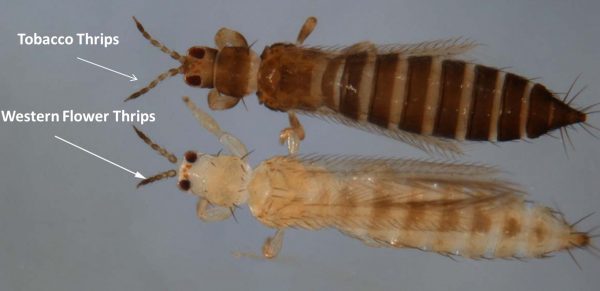
Figure 6. Both tobacco thrips and western flower thrips are TSWV vectors in Alabama peanut fields.
Nine thrips species are known vectors of TSWV worldwide. In Alabama, three of the four species that occur in peanut fields are known TSWV vectors. Tobacco thrips, F. fusca (Hinds), is by far the most abundant (figure 6). Western flower thrips, F. occidentalis (Pergande), is an efficient vector of TSWV and is more abundant later in the season when nymphs and adults can hide in and around flowers (figure 6). Two other species of flower thrips, F. tritici (Fitch) and F. bispinosa (Morgan), occur at low levels on peanuts, but only F. bispinosa is a known vector of TSWV.
Tobacco thrips emerge from the soil or crop residue in early spring and move to various hosts such as clovers, vetch, small grains, henbit, and other weeds. As weedy hosts senesce, tobacco thrips then infest various row crops, including emerging peanut seedlings. In contrast, western flower thrips are active throughout the winter on annual winter weeds. Western flower thrips migrate to spring weeds where they reproduce before infesting peanuts in late April and early May. Western flower thrips can also remain very active and transmit TSWV in mid- to late-season in vegetable crops that are successively planted. The Tobacco Thrips Flight and TSWV Intensity predictor tool, developed by North Carolina State University, provides a resource to monitor thrips flights and predict the risk of TSWV in a given field. These predictions are based on more than 30 years of thrips trapping and weather data.
In Alabama, thrips populations typically peak on peanuts between 2 and 4 weeks after emergence and decline sharply after 6 weeks. Thrips injury on peanut seedlings is more obvious at this stage because their growth is slow. Thrips injury in peanuts is characterized by scarring and deformation of new leaves, which often results in stunted, slow-growing seedlings (figure 7); however, healthy peanuts usually outgrow most thrips injury.
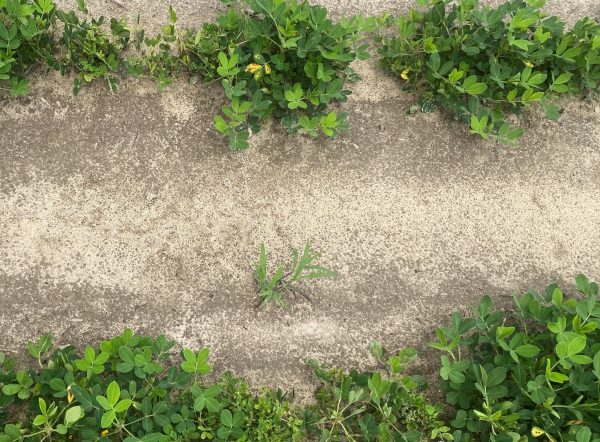
Figure 7. Thrips injury in peanuts resulting in stunted, slow-growing seedlings.
Adult female thrips readily infest newly emerged peanut fields and lay eggs between the young, folded leaflets. Eggs hatch 3 to 5 days after being laid, and the first- stage larvae emerge and feed for about 2 days. The first larval stage is the most efficient stage of the life cycle to acquire TSWV. With each successive molt, thrips become less efficient in acquiring the virus. Thrips larvae range from pale to bright yellow with bright red eyes.
Thrips feed for 3 to 5 days during the second larval stage before changing into a nonfeeding, inactive prepupal stage, followed by a pupal stage. During this time, thrips do not feed, thus they do not acquire or transmit TSWV. Adult thrips emerge from the pupal stage after about 3 days. The average time required to complete the life cycle from egg to adult is approximately 13 days for tobacco thrips in Alabama. Adult thrips are the primary vectors of TSWV because they are highly mobile.
Adult female tobacco thrips are small (1.3 millimeters) and dark brown. Male tobacco thrips are smaller (1 millimeter) and pale yellow. Both sexes occur in winged or wingless forms. During the growing season, the ratio of females to males may be 6 to 1 or greater. The average life span of an adult female is about 33 days. Female western flower thrips are also small (1.5 millimeters), with a yellow to blotchy brown abdomen. Males are smaller (1 millimeter), with a pale yellow body.
Virus Source
To date, the overwintering source of TSWV has not been identified in Alabama. Several common winter weeds are known hosts of TSWV and can function as overwintering sources for the virus and thrips; however, random surveys across Alabama peanut fields have not identified any TSWV-infected winter annual or perennial weed hosts.
The only weed found to be infected with TSWV in Alabama is Florida beggarweed, which is commonly found in peanut fields that have relatively high levels of TSWV. Since Florida beggarweed is a summer annual, it is likely unimportant for the season-to-season survival of TSWV.
As in other crops, the early-season influx of viruliferous thrips is the primary inoculum source of TSWV in peanuts. Adult thrips carrying TSWV overwinter in the soil and crop debris and transmit the virus at or shortly after seedling emergence. More study is needed to identify possible weed and crop reservoirs of TSWV and to determine whether virus-carrying thrips overwinter in Alabama.
Management Practices
Management practices such as cultivar selection, planting date, seed quality, soil insecticides, and tillage practices when used in combination will reduce the incidence of TSWV in peanuts. Losses can be reduced by adopting the following Integrated Pest Management (IPM) strategies.
Plant a TSWV-Resistant Cultivar
Peanut cultivars with partial resistance to TSWV are commercially available, but their performance can vary depending on pest pressure. When selecting cultivars, take into consideration the risk of other pests such as root-knot nematodes, white mold, and leaf spot diseases. For more information about commercial peanut cultivars, visit the Peanut Rx Guide web page, which is updated yearly and developed by the University of Georgia in cooperation with Auburn University, the University of Florida, and Mississippi State University.
Avoid Planting Peanuts Early
Peanuts planted before May 1 are the most at risk for TSWV and thrips damage. The highest levels of TSWV generally are seen in peanuts planted in early to mid- April. If planting peanuts before April 25, always use a TSWV-resistant cultivar. Early to mid-May planted peanuts are at lower risk from TSWV. Virus levels often increase again for peanuts planted from late May to early June.
Consider Seeding Rates, Plant populations, and Row Patterns
Uniform emergence, good ground cover, and vigorous seedling growth can reduce the risk of TSWV. Plant peanut seeds with high germination rates at the recommended seeding rate in a well-prepared seedbed when soil temperatures and moisture conditions favor uniform germination and rapid seedling growth. In cool, wet soils, do not use any pesticides that will slow seed germination or seedling growth. Thin, skippy stands of peanut seedlings are a magnet for the thrips vectors of TSWV. Twin-row planting also leads to faster ground cover and reduced incidence of TSWV than single-row planting.
Consider Tillage Practices
Striped/reduced tillage practices can suppress TSWV by as much as 42 percent compared to conventional tillage practices. Studies have found that surface crop residue reduces the number of thrips landing in infesting peanut fields, thus reducing TSWV infection risk.
Apply Insecticides Preventatively
Thrips are the most common early-season insect pest of peanuts. In-furrow liquid or granular insecticides are commonly applied at planting to prevent delays in maturity from thrips injury. With the exception of one granular in-furrow treatment, insecticides will not prevent incoming virus-carrying thrips from transmitting TSWV to peanuts. Certain soil-applied insecticides may increase TSWV (e.g., imidacloprid). In some cases, foliar applications may be needed to supplement at-plant insecticides; however, this is not likely to slow the spread of TSWV in peanuts. Current recommended thresholds and insecticide options can be found in Extension publication IPM-0360, “Peanut IPM Guide.”
Do not overapply insecticides without recording insect pest and natural enemy activities. Protect natural enemies by adjusting spray schedule. Call an agronomic crops regional Extension agent for insect pest or disease identification before making a spray decision. Always read the pesticide label. Do not apply pesticides at rates below or higher than the recommendation to prevent or slow down resistance development.
References
Cantonwine, E. G., Culbreath, A. K., Stevenson, K. L., Kemerait Jr, R. C., Brenneman, T. B., Smith, N. B., and Mullinix Jr, B. G. 2006. Integrated disease management of leaf spot and spotted wilt of peanut. Plant Dis. 90:493-500.
Parrella, G., Gognalons, P., Gebre-Selassie, K., Vovlas, C., and Marchoux, G. 2003. An update of the host range of Tomato spotted wilt virus. J. Plant. Pathol. 227-264.
Rotenberg, D., Jacobson, A. L., Schneweis, D. J., and Whitfield, A. E. 2015. Thrips transmission of tospoviruses. Curr. Opin. Virol. 15:15, 80-89.
Srinivasan, R., Riley, D., Diffie, S., Shrestha, A., and Culbreath, A. 2014. Winter weeds as inoculum sources of Tomato spotted wilt virus and as reservoirs for its vector, Frankliniella fusca in farmscapes of Georgia. Environ. Entomol. 43, 410–420.
Srinivasan, R., Abney, M. R., Culbreath, A. K., Kemerait, R. C., Tubbs, R. S., Monfort, W. S., and Pappu, H. R. 2017. Three decades of managing Tomato spotted wilt virus in peanut in southeastern United States. Virus Res. 241:203-212.
 Amanda Strayer-Scherer, Extension Plant Pathologist, Assistant Professor, and Scott Graham, Extension Entomologist, Assistant Professor, Entomology and Plant Pathology, both with Auburn University
Amanda Strayer-Scherer, Extension Plant Pathologist, Assistant Professor, and Scott Graham, Extension Entomologist, Assistant Professor, Entomology and Plant Pathology, both with Auburn University
Revised August 2021, Tomato Spotted Wilt Virus on Peanuts, ANR-0574

